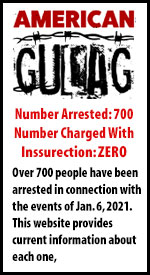Video: Dan Smoot - Our Form of Government is Supposed to be a Constitutional Republic NOT a Democracy
This is a classic presentation by Dan Smoot back in 1966, a wonderful reminder of how the United States Government was intended to function. Daily we hear politicians and media screaming about how "our democracy is at risk!" Well, hell yes. THEIR FORM OF GOVERNING IS A DEMOCRACY NOT A REPUBLIC AS IT SHOULD BE!
Transcript:
A CONSTITUTIONAL REPUBLIC, NOT A DEMOCRACY
A. democracy is a political system in which the people periodically, by majority vote at the polls, select their rulers. The rulers then have absolute power to make whatever laws they please, by majority vote among themselves. In a constitutional Republic, the people also, by majority vote at the polls, select rulers, who make laws by majority vote among themselves; but the rulers cannot make any laws they please, because the Constitution severely restricts their law-making power.
The ideal of a democracy is universal equality. The ideal of a constitutional Republic is individual liberty.
Subversion of Language
In this century, great strides have been made toward the goal of subverting our Republic and transforming it into a democracy. One tactic of the subverters is subversion of language. By calling the United States a democracy until people thoughtlessly accept and use the term, totalitarians have obscured the real meaning of our principles of government.
Note the following passages from an article written by C. L. Sulzberger and distributed by the New York Times News Service (March 3, 1966):
“Not only in the United States but in other leading democracies, recent years have seen perceptible growth in executive authority ....
“Amaury de Riencourt, a French intellectual, contends in his book, The Coming Caesars, that ‘as society becomes more equalitarian, it tends increasingly to concentrate absolute power in the hands of one single man.’ . . .
“ ‘ Caesarism is not.... brutal seizure of power through revolution. It is not based on a specific doctrine or philosophy. It is essentially pragmatic and untheoretical. It is a slow, often century-old, unconscious development that ends in a voluntary surrender of a free people escaping from freedom to one autocratic master.’ ”
We are "escaping from freedom to one autocratic master” trading our liberty for the promise of equality; but the operation is not an "unconscious development.”
Note the following from Page 9 of Gunnar Myrdal’s An American Dilemma :
“In society liberty for one may mean the suppression of liberty for others .... In America . . . liberty often provided an opportunity for the stronger to rob the weaker. Against this, the equalitarianism in the [American] Creed has been persistently revolting. The struggle is far from ended. The reason why American liberty was not more dangerous to equality [in the early days of the nation] was, of course, the open frontier and the free land. When opportunity became bounded in the last generation, the inherent conflict between equality and liberty flared up. Equality is slowly winning . . . .”
And the following from page 13:
“[In] America .... conservatism . . . has, to a great extent, been perverted into a nearly fetishistic cult of the Constitution. This is unfortunate since the 150-year-old Constitution is in many respects impractical and ill-suited for modern conditions and since, furthermore, the drafters of the document made it technically difficult to change even if there were no popular feeling against change.
“The worship of the Constitution also is a most flagrant violation of the American Creed . . . . Modern historical studies of how the Constitution came to be as it is revealed that the Constitutional Convention was nearly a plot against the common people.”
Gunnar Myrdal, a Swedish socialist, was hired by the Carnegie Corporation of New York in 1937 to direct a study of the Negro in the United States. Myrdal arrived in this country in September, 1938, engaged a large staff (some of them communists and pro-communists), and began his work. He was aided by several branches of the federal government, by some state and municipal authorities, by the NAACP, by the National Urban League, by private and public research institutions, by universities, by numerous individuals considered intellectual leaders of the day. An American Dilemma resulted, completed in 1942, first copyrighted in the United States in 1944.
On May 17, 1954, the Supreme Court handed down its school-segregation decision, which deliberately violated the Constitution, reversed previous Supreme Court decisions, and lit a fuse touching off explosive lawlessness which has been shattering our society ever since. The Court cited An American Dilemma as one of the "modern authorities” on which it relied, in preference to the Constitution, for justification of its decision.
An American Dilemma provided a basic rationale for the conversion of our free Republic into an equalitarian democracy. Evidence of Gun¬ nar Myrdal’s malignant and continuing influence on American life can be found in The Negro Family: The Case For National Action, prepared and published in March, 1965, by the Office of Policy Planning and Research, United States Department of Labor. This government study repeats Myrdal’s thesis that liberty and equality are in¬ compatible, holding that equality must be our national goal. Note these passages from Pages 2 and 3:
“Liberty and Equality are the twin ideals of American democracy. But they are not the same thing .... nor . . . are they always compatible ....
“By and large, liberty has been the ideal with the higher social prestige in America. It has been the middle-class aspiration, par excellence. (Note the assertions of the conservative right that ours is a republic, not a democracy.) Equality, on the other hand, has enjoyed tolerance more than acceptance. Yet it has roots deep in Western civilization and is at least coeval with, if not prior to, liberty in the history of Western political thought.”
The Big Lie
Note that the government book unequivocally labels America a democracy, characterizing as merely an assertion the truth that America is a Republic.
Here again, we see the influence of the Swedish socialist, Gunnar Myrdal. Myrdal contends that the American Declaration of Independence (1776) proclaimed the ideal of an equalitarian democracy (because it contains the phrase, "All men are created equal”). Eleven years later (1787), the Constitutional Convention produced the Constitution which created, not a democracy founded on the ideal of equality, but a Republic founded on the ideal of liberty. This is why Myrdal says the "Constitutional Convention was nearly a plot against the common people.” But he and those who parrot his ideas are either ignorant or dishonest.
The Declaration’s phrase, all men are created equal, means that men are equal before the Creator, regardless of their inequality in human society. The Declaration says that men are endowed with unalienable rights and that the purpose of government is to secure these rights. The unalienable rights of man enumerated in the Declaration of Independence do not include equality, but they do include liberty, along with life and pursuit of happiness.
Equality of all men in the eyes of God and before the law is a condition essential to freedom; but no other kind of equality is possible. Govern¬ ment efforts to achieve material equality will produce crushing tyranny, but will not make people equal.
The Great Truth
The continuity of ideals from the Declaration of Independence to the Constitution is clear to serious students of American history. The fact that Madison, known as father of the Constitution, was a disciple and lifelong friend of Jefferson, author of the Declaration, should be enough to squelch the assertion that there is conflict of principles in these two documents. The Constitution was ordained in 1787 specifically to safeguard the principles of liberty proclaimed by the Declaration of Independence in 1776.
The writers of the Constitution were anxious to safeguard liberty against dictatorship ( monarchy, they called it); but their chief anxiety was to protect the country against democracy.
Edmund Randolph, delegate to the Constitutional Convention from Virginia, said the "general object” of the Convention was to "provide a cure for the evils” which beset the country, claiming that "in tracing these evils to the origin,” every man had found them to be in the "turbulence and follies of democracy.” He urged the Convention to produce a means to "check . . . and to restrain, if possible, the fury of Democracy.”
Elbridge Gerry and Roger Sherman, delegates from Massachusetts and Connecticut, urged the Constitutional Convention to create a system which would eliminate "the evils we experience,” saying that those "evils . . . flow from the excess of democracy.”
Alexander Hamilton, delegate from New York, said:
“We are now forming a republican government. Real liberty is neither found in despotism nor the extremes of democracy, but in moderate governments .... if we incline too much to democracy, we shall soon shoot into a monarchy.”
John Adams (not a delegate to the Constitutional Convention, but one of the giants of the American revolutionary period) said:
“ . . . democracy will envy all, contend with all, endeavor to pull down all; and when by chance it happens to get the upper hand for a short time, it will be revengeful, bloody, and cruel . . . .”
Speaking of "pure democracies” (in which the people, by majority vote, act as their own lawmakers, instead of electing representatives to make laws), James Madison said:
“. . . such democracies have ever been . . . incompatible with personal security or the rights of property ....
“A republic, by which I mean a government in which the scheme of representation takes place, opens a different prospect, and promises the cure for which we are seeking . . . .”
Madison did not, however, think the "scheme of representation” was enough to protect the people from tyranny. He knew, and said, that "enlightened men will not always be at the helm” of government to serve as "proper guardians of the public weal.” He knew that unlimited political power cannot safely be entrusted to the nation’s elected representatives, to use as a majority of them see fit, because, he said, a majority of a group of men is far more likely to be tyrannical than one man is.
In a democracy, if a majority should develop hatred for all blue-eyed babies and order them eliminated, the babies could be legally executed, because whatever a majority wants, at any given moment, is supreme law of the land, in a democracy.
Our Constitutional System
How can liberty be safeguarded against the mindless, soulless tyranny of majority rule, when



















